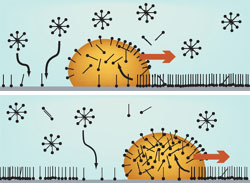Motoring Oil Drops

Molecular motors inside living cells can turn chemical energy directly into work–a feat that technology still cannot replicate. In the 18 February PRL, Japanese researchers describe the cyclical motion of oil droplets powered by the repulsion between oily and watery molecules, a principle that is similar to biological motors and one which they believe could power nanomachines of the future. Such technology would produce no waste heat and so could work with much higher efficiency than any internal combustion engine.
A “running droplet” rolls around on a solid surface using electrostatic or chemical energy. In a recent experiment [1] for example, the droplet consisted of an oily substance with so-called surfactant molecules floating inside. These molecules have “water-loving” (hydrophilic) heads and “water-fearing” (hydrophobic) tails, much like ordinary soap molecules. Some of the hydrophobic tails attached themselves permanently to the specially-treated solid surface, leaving their hydrophilic ends pointing upward inside the droplet. Repulsion between this continuously forming watery layer and the rest of the oily droplet above propelled the droplet to constantly move, and it could never return to the same location twice. Researchers are interested in the fundamental physics of such motion, as well as possibly using it in nanotechnology.
Yutaka Sumino and his colleagues at the University of Kyoto in Japan found a way to make the “motor” more effective by allowing it to trace the same path over and over. At the start of their experiment in a glass petri dish, they dissolved the surfactant in a water bath surrounding the oil droplet; the oil contained only potassium iodide, a salt which helps oil soak up surfactant molecules. These molecules were attracted by the negatively charged glass and stuck their positively charged heads to the bottom, creating an oily “kelp forest” with their tails. Once the droplet began moving from random motions, it “mopped up” much of the surfactant in its path, leaving a trail of relatively clean glass, which is hydrophilic. The exposed glass propelled the droplet from behind, while the “kelp forest” attracted it in front. After a droplet went by, surfactant floating in the water quickly restored a hydrophobic layer on the glass surface, preparing it for another passage.
The droplet moved randomly at first, but once it hit the round petri dish’s walls, it started orbiting continuously around the dish, says Sumino’s Kyoto collaborator Kenichi Yoshikawa. When the researchers replaced the round dish with a long and thin container–about as wide as the droplet itself–the droplet simply paced back and forth from one end to the other. The walks stopped after less than a minute, or 20 to 50 cycles, when the droplet became saturated with surfactant.
Irving Epstein of Brandeis University in Boston is impressed by the new work, which he says “might spawn the development of new devices.” He adds that it is possible that some living cells use similar effects to get around, although that is not known. Yoshikawa has high hopes for future nanomachines that would move through the human bloodstream and make repairs. “Perhaps in the future you can make small chemical robots that walk in a narrow space by utilizing energy from the environment–for example, glucose,” he says.
–Davide Castelvecchi
Davide Castelvecchi is a freelance science writer in Rome.
References
- S-W Lee, D. Y. Kwok, and P. E. Laibinis, “Chemical Influences on Adsorption-Mediated Self-Propelled Drop Movement,” Phys. Rev. E 65, 051602 (2002)


